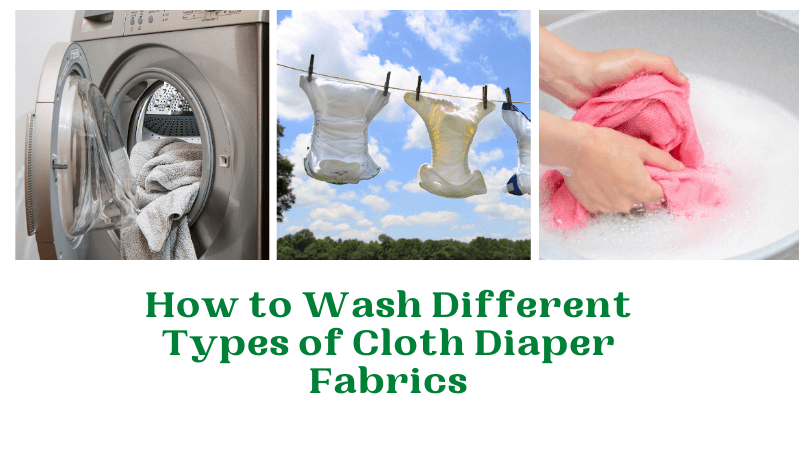You throw all your dirty diapers into the same diaper pail, so it would seem to make sense that all those diapers can be thrown in the washer and dryer together.
Yes.
And No.
Yes, you could throw them all in the washer and dryer together, but the different fabrics in cloth diapers need different care. Alas, the high heat of the dryer can damage PUL and TPU covers, but if you dry everything on low, some items like your diaper inserts, fitteds, prefolds, ect, are going to take forever to dry.
So what do you do?
Understanding the needs of different fabric types can help shed some light on creating a washing system that’s going to be effective and elongate the life of your diapers. Just keep in mind that the high heat of the dryer will wear out diapers faster. It’s better to stick with medium for natural fibers and low heat or hang dry covers.
Another thing to note: avoid fabric softeners and chlorine bleach like COVID. Seriously, fabric softener can build up on diapers and cause them to repel liquid instead of absorbing it. Chlorine bleach damages fibers and will shorten the life of your diapers. If you really need to bleach them, use a non-chlorine bleach like oxiclean. For persistent stains, the sun offers a natural- and free! – way to bleach out those spots.
If you want a more in depth look at the different fabrics used in cloth diapering, you can read this post.
PUL and TPU
PUL and TPU are both laminate fabrics. That means that a layer a polyurethane laminate is bonded to a polyester knit fabric. However, that layer of laminate is very susceptible to high heat. Wazoodle states in the washing instructions for PUL, that high heat can shorten the life of the fabric, but also cause it to warp or melt.
If you’ve ever pulled diaper covers out to the dryer and noticed that the inside of the covers have creased and stuck together (which then you have to carefully peel apart) then you’re probably drying them on too hot of heat.
Rubber, Vinyl, and Nylon
NEVER put these babies in the dryer. Or washer, for that matter. If you accidently wash them in the machine, they’d probably survive, but accidentally put them in the dryer and it’s game over. The high heat will crack and melt diaper covers made from these fabrics.
Most manufacturers recommend hand washing and hanging to dry rubber, vinyl and nylon covers. These covers can be reused multiple times before being washed, so if it’s particularly damp after use, just let it air dry before using it again.
To wash, simply put a few drops of detergent in a sink of warm water and gently clean the covers. Then hang to dry.
Cotton, Bamboo, Hemp, Zorb
Ah, natural fibers. So soft. So absorbent. So able to handle the use and abuse that cloth diapering demands. These fabrics can withstand washing on hot and drying on medium heat, though they will shrink when washed the first couple of times. Hemp, in particular, shrinks ENORMOUSLY. I’ve washed 2 yards of hemp and had it shrink over 12 inches after 2 washings.
These fabrics, especially hemp and bamboo, have natural oils in the fabric which will inhibit moisture absorption until they have been washed out. For bamboo, most companies suggest prewashing 3-4 times. For hemp, prewashing 8 times to reach maximum absorbency. When you wash these materials the first few times, make sure you wash them separate. The oils from the fabric can affect a diaper cover’s ability to repel water.
One diaper company, Pooters Diapers, advise washing hemp separate from any other fleece fabrics as well for the same reason. You can still use diapers before hitting the recommended prewashing numbers, just know that they may not absorb their max capacity until you do.
If the long drying time of natural fibers frustrates you, throw some dryer balls into the dryer with them to decrease drying time. Do NOT use dryer sheets. Ever. For any cloth diapering item.
Polyester
Polyester comes in many shapes and forms in the world of cloth diapering; microfiber, minky, and stay-dry fabrics like microfleece. A synthetic fabric, you can wash them on hot, warm, or cold.
Remember, a good rule of thumb to elongate the life of your diapers is to avoid drying on high heat. You do not need to prewash polyester fabrics prior to use, although it’s always good practice to wash items once before use to get rid of any particles left behind by the manufacturing process.
Wool
Like rubber, vinyl, and nylon covers, drying wool in the dryer will ruin your covers. Never machine wash or dry your wool covers. The heat of the dryer will shrink the fibers in a wool cover, making it doll size instead of human size. If you’ve ever dried a wool sweater in the dryer, you know exactly what I’m talking about.
To wash, use a few drops of detergent meant for wool and fill a sink or container with warm water. Place cover in water and gently massage the fabric until it’s saturated. Dump or drain water and squeeze excess water from cover, careful to not twist or stretch the fabric. Fill sink or container with more warm water. Rinse covers and squeeze out excess water.
You can roll the covers up in a clean towel to get even more moisture out. Lay flat to dry. Do not hang as that will distort the shape of the cover.
To maintain waterproof quality, wool needs to be periodically lanolized. To do this, melt a pea sized drop of lanolin in a small amount of hot water until melted. Add to warm water and clean covers. Let covers soak 15 minutes to overnight. Get rid of excess water and lay flat to dry.
Things to Remember
1. High dryer heat is not your diapers’ friend. You can dry on high, but expect your diapers to wear out sooner.
2. Dry natural fibers on medium and synthetics and PUL/TPU on low or line dry.
3. Hand wash and line or lay flat to dry covers made from vinyl, nylon, rubber, and wool.
4. Never use fabric softener, chlorine bleach, or dryer sheets.
5. Pre-rinse dirty diapers whenever possible.
6. There’s a lot of contradictory info regarding detergent, but most mainstream detergents work just fine.
Sources:
https://www.wazoodle.com/knowledge-base/pul-information/pul-care.html
http://realdiapers.org/wash/laundry-science
https://fluffloveuniversity.com/how-to-wash-cloth-diapers/wool-care/
Alecia
Latest posts by Alecia (see all)
- Best Adult Diaper Covers - March 7, 2024
- Best Fabrics for Making Adult Diaper Covers - February 16, 2024
- How to Use the Zigzag Stitch - May 4, 2023


